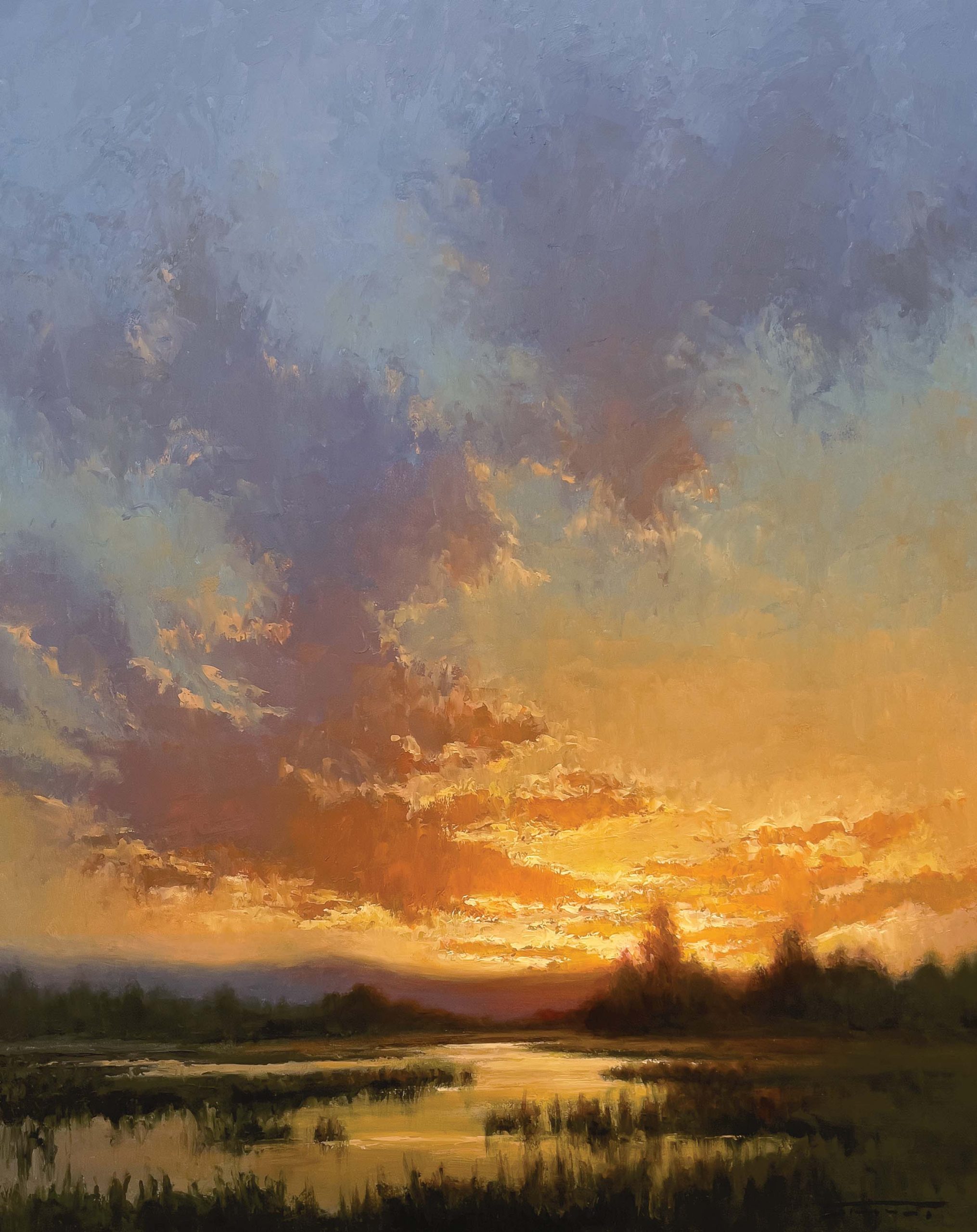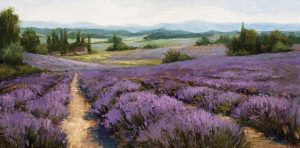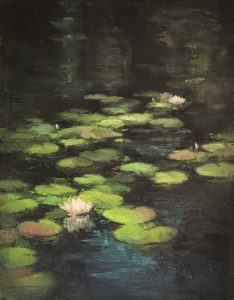
02 May The Reprieve of Beauty
In a world that can often be overwhelming, Colorado artist Jane Hunt finds solace and inspiration in the quiet beauty of the landscape. Her paintings, however, do not portray the grandiose scenes that easily inspire awe, such as detailed depictions of the rust-red expanse of the Grand Canyon or the sharp, snowcapped peaks of the Grand Teton; instead, her work celebrates the understated moments of beauty found in nature, places where the environment speaks to you softly.

Lavender Fields | Oil | 18 x 24 inches
“It is the small moments,” says Hunt, adding that even though Colorado is known for its mountains, they tend to appear in the backdrop of her paintings. “I’m more interested in the pastoral, universal scenes. I like to see the beauty in the everyday.”
Hunt hopes her work will elicit an emotional response and impart a peaceful reprieve for her viewers. “I’d rather be on the side of supplying some comfort to other humans,” she says, “and I see that as one of my goals in life.”

Late Summer | Oil | 11 x 14 inches
Seth Hopkins, executive director at the Booth Western Art Museum, says that this emotive, universal quality makes Hunt’s paintings special. And he likens her work to that of photographer Ansel Adams [1902 – 1984]. “I would say Ansel Adams was the best at being able to make you feel what he felt, not see what he saw. And I think that’s the way her work comes across to me,” Hopkins says. “Any painter worth their salt can go to the Grand Canyon and the Tetons and paint an impressive painting. But if you blindfolded them and took them down a random road anywhere in the country and just dropped them off somewhere that was a fairly unremarkable landscape, could they produce a beautiful painting or an emotional painting in an everyday setting? I think Jane has the ability to do that. And I think a lot of that comes from the glow that’s in many of her works.”

Peace in the Valley | Oil | 14 x 11 inches
Take the painting Peace in the Valley, for example, which depicts the towering sandstone buttes found in Monument Valley. “She’s actually downplayed the drama of Monument Valley,” Hopkins notes, “which is one of the most dramatic places I’ve ever been or ever seen, and softened it to the point where you barely recognize that’s what it is. It’s such an effective painting and still has that emotional content, but it’s not playing on the natural features and the natural drama of that place. … I mean, that takes guts.”
According to Hunt, art was all she ever wanted to do. While growing up in London, she visited museums with her parents, who loved Impressionism. The young artist found her muse in the ethereal quality of J.M.W. Turner’s work and Monet’s lilies in Giverny.

Autumn Aspens | Oil | 30 x 24 inches
She moved to the U.S. as a teenager and received her bachelor’s in illustration from the Cleveland Institute of Art in 1993. Hunt planned to become a scientific illustrator, but she found the intervention of technology, such as Photoshop and Illustrator, too sharp of a departure and quickly turned to fine art. Hunt moved to Colorado at age 25, where she discovered a sense of familiarity in the wide-open spaces reminiscent of her childhood in England, and she began painting the landscape to cope with the homesickness she experienced.

Headed Home | Oil | 18 x 24 inches
Today, Hunt and her family live “on the side of a mountain” between Lyons and Boulder, where she recently completed remodeling her dream studio. “We can see for about 90 miles looking out from my studio window. It’s truly amazing,” she says, adding that “the vastness and the open-ended promise of the land keep me here. I love it.”
Hunt’s approach to painting is deeply rooted in technical skill. She often paints en plein air and will use photos for reference, but her work is generally an imagined location or an aggregate of a place — somewhere that gives her a feeling of peacefulness or home. Her paintings often depict the sky, which is a universally appealing subject. “And there’s some symbolism in the paintings themselves. Sunset and sunrise are, I guess, a nod to issues that are a little bit bigger than all of us and that could comfort people during what is kind of a tumultuous time to be alive. So that’s my hope, really, is that it gives people kind of a gentle place to rest and get a little haven for a while,” Hunt says.

Summer Lilies | Oil | 14 x 11 inches
Her paintings, though soft and ethereal, are imbued with texture and depth, which she achieves through her brushwork and palette knife techniques. The luminous painterly quality is marred with hard lines to create visual interest. “I can put the paint on really quickly with the knife, and then I tend to soften it out with the brush, and it’s this sort of push and pull until I get it the way I like it,” Hunt says. “I’ll scrape in with a knife, or with the end of my brush, or whatever I have laying around, frankly, gouge away, scrape away the paint a little bit.”
Drawing on elements of Tonalism and the romantic quality the style imparts, Hunt uses value to convey emotion, orchestrating light and dark elements within the composition to guide the viewer’s gaze across her canvases. She also focuses on the psychology of color to create a mood. “I’m generally working in three to five large value masses, so if someone really pares down my paintings, they’ll see that they’re usually comprised of just a few big shapes,” the artist explains, adding that “within those big shapes, that’s where all the fun stuff happens, the color, and the texture, and all the playing around. But getting it to the right composition with just a few solid shapes that move the viewer’s eye around, or the places I want them to, that’s the tricky bit.”

Boats at Dusk | Oil | 20 x 16 inches
Hunt has mastered sharing these subtle moments of natural beauty so well that she is among the top 15 most highly awarded artists in the U.S., with more than 200 awards, according to ARTDATAintel. This summer, she will participate in The Woolaroc Museum’s Women Artists of the West Invitational Exhibition & Sale, May 4 through August 4. For the show, she painted a large version of Into the West, one of her favorite sunset paintings. For the Buffalo Bill Art Show & Sale, September 16 through 24, she plans to re-create Stillness in a large format. She also has a show at Turner Fine Art in Jackson, Wyoming, this summer and creates work for her representing galleries, Illume Gallery in Philipsburg, Montana, and Wild Horse Gallery in Steamboat Springs, Colorado.
Her upcoming March 2025 artist residency at the Booth Western Art Museum in Cartersville, Georgia, is also a testament to her talent and dedication as an artist. During the two-week residency, she will create a painting that will be added to the museum’s permanent collection. Additionally, she will conduct a workshop, sharing her process and techniques with aspiring artists, and will participate in discussion panels with the public. Hunt describes the residency as “an enormous honor.”

Stillness | Oil | 15 x 24 inches
“Some of my heroes are in [the Booth Museum], so the fact that I’ll get to hang in that permanent collection is really quite exciting,” she says. “I’m hugely honored to be hanging with the historical artists that they have there, and I also really appreciate that the Booth represents and supports living artists.”
Kent Mullinax, the Art Academy manager at Booth Western Art Museum, says that the residency allows a new generation of artists to contribute to the legacy of the West. “From a personal standpoint, Jane’s work makes me feel like I’ve been to the places in her paintings and even stood where she stood. I think that visitors to the museum will feel that emotional connection as well,” he adds.
Through her art, Hunt has found healing and comfort, and she hopes to extend that solace to others. She invites us to linger in the beauty, available even in unexpected places, and find connection through its universal appeal.






No Comments